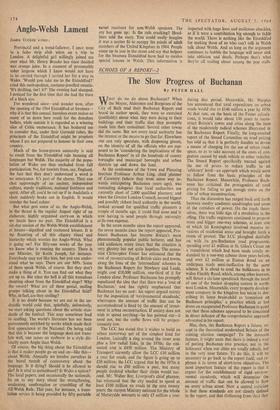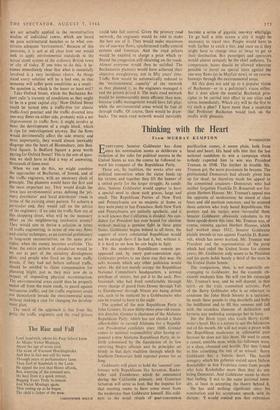ECHOES OF A REPORT-2
The Slow Progress of Buchanan
By PETER HALL
WHAT do we do about Buchanan? When the Mayor, Aldermen and Burgesses of the City of Bath read their Buchanan Report and heard its author speak, they were so exercised (justifiably) about what they were doing to their buildings and their traffic that they promptly made him their consultant. Several other towns did the same. But not every local authority has the interest or the means to go that far. Elsewhere one can only speculate, with deepening gloom, on the identity of all the officials who are sup- posed to be 'considering the implications of the Buchanan Report' in all the hundreds of county boroughs and municipal boroughs and urban districts up and down the land.
At the conference of the Town and Planning Institute Professor Arthur Ling, chief planner of Coventry (where they went some way to- wards anticipating Buchanan years ago), was reminding delegates that local authorities are currently short of 2,000 qualified planners; and when the Greater London Council, second biggest and possibly richest local authority in the world, looked around for qualified traffic planners a couple of months ago, it could find none and is now having to send people through university at its own expense.
In the seven months since the report appeared, the seven months since the report appeared, Pro- fessor Buchanan has become Britain's most phenomenally popular public lecturer, and has told audiences many times that the situation is very gloomy but not quite hopeless. The econo- mist Christopher Foster has estimated that the cost of reconstructing all British cities and towns, along the lines of the 'intermediate' schemes in the Buchanan Report for Newbury and Leeds, might cost £18,000 million, one-third of it for London alone. Professor Buchanan has promptly repudiated the idea that that there was a 'cost of Buchanan,' and has rightly emphasised that Buchanan has no cost: his report argued merely for the imposition of 'environmental standards,' whereupon the amount of traffic that can be accommodated is fixed by the amount of invest- ment in urban reconstruction. If society does not wish to spend anything—he has pointed out—it need not, but the traffic flows will be propor- tionately low.
The LCC has stated that it wishes to build an urban motonvay net of the simplest kind for London, basically a ring around the inner area plus a few radial links, in the 1970s; the esti- mated cost is £450 million. The Ministry of Transport currently allow the LCC £10 million a year for roads, and the figure is going up to £20 million; the LCC argued that by the 1970s it should rise to £90 million a year, but many people doubted whether their claim would suc- ceed. Mr. Walter Bor, Liverpool's chief planner, has estimated that the city needed to spend at least £100 million on roads in the next twenty years; the current Ministry estimate for the whole of Merseyside amounts to only £3 million a year
during that period. Meanwhile, Mr. Marples has announced that total expenditure on urban roads would rise to £140 million a year by 1970. At that rate, on the basis of the Foster calcula- tions, it would take about 130 years to recon- struct Britain's towns and cities along the lines of the moderately radical schemes illustrated in the Buchanan Report. Finally, the long-awaited report of the Smeed Committee on road pricing has told us that it is perfectly feasible to devise a means of charging for the use of urban road- space, so as to take account of the costs of con- gestion caused by each vehicle to other vehicles. The Smeed Report specifically warned against the use of prices to reduce traffic to an 'arbitrary' level—an approach which would seem to follow from the basic principles of the Buchanan Report. Meanwhile, Professor Buch- anan has criticised the protagonists of road pricing for failing to put enough stress on the role of urban reconstruction.
Thus the discussion has ranged back and forth between sundry academic quadrangles and some of the corridors of power. On the roads them- selves, there was little sign of a revolution in the offing. The traffic engineers continued to propose more and bigger one-way schemes, at least one of which (in Kensington) involved massive in- vasions of residential areas and brought forth a storm of protest. The LCC ploughed dutifully on with its pre-Buchanan road programme, spending over £1 million at St. Giles's Circus on a roundabout which had been made totally re- dundant by a one-way scheme three years before, and over £2 million at Euston Road on an underpass nude semi-ineffective by the same scheme. It is about to send the bulldozers in to widen Finchly Road, which, among other horrors, will thrust a six-lane speedtrack through the heart of one of the busiest shopping centres in north- west London. Meanwhile, every property develop- ment company in the kingdom has taken to des- cribing its latest brain-child as 'conceived on Buchanan principles,' a practice which at last drove an exasperated Professor Buchanan to point out that these schemes appeared to be conceived in direct defiance of the comprehensive approach advocated in his report.
Has, then, the Buchanan Report a future, ex- cept in the theoretical modernised Britain of the coming election campaign? To the innocent layman, it might seem that there is indeed a way of putting Buchanan into practice, not in the holocaust when our cities arc totally rebuilt, but in the very near future. To do this, it will be necessary to go back to the report itself, and re- phrase it in terms of short-term objectives. The most important feature of the report is that it argues for the establishment of rigid environ- mental standards, which will determine the amount of traffic that can be allowed to flow on every urban street. Now a central criticism is that these standards are not closely defined in the report, and that (following from, this) they
are not actually applied in the reconstruction studies of individual towns, which are based on pure architectural hunches as to what con- stitutes adequate 'environment.' Because of this omission, it is not at all clear how one would seek to apply environmental standards to the actual street system of the ordinary British town or city of today. If one tries to do this, it be-
comes immediately clear that what is essentially involved is a very invidious choice. As things stand every solution will be a bad one, in that someone will suffer poor conditions as a result: the question is, which is the lesser or least evil?
Take Oxford Street, which the Buchanan Re- port calls 'a travesty of conditions as they ought to be in a great capital city.' Now Oxford Street could be turned into a traffic-free (or almost traffic-free) precinct and the traffic diverted into one-way flows on either side, probably with a net improvement to traffic flow; it might involve at most the development of a single block, which is ripe for redevelopment anyway. But the flows would detrimentally affect the side streets; and most importantly, they would almost inevitably disgorge into the heart of Bloomsbury, into Bed- ford Square. Is Bedford Square a price worth paying for Oxford Street? This is the sort of ques- tion we shall have to find a way of answering, thousands of times over.
When we can do this, we might combine the approaches of Buchanan, of Smeed, and of the traffic engineers, with no necessary clash of principle. The planners would have the first and the most important say. They would divide the town into environmental areas, defining the 'pri- mary distributor' and 'local distributor' roads in terms of the existing street pattern. To achieve a Particular end, they would call on the advice of the engineers: if we take the traffic flow out of this shopping street, what will be the necessary effect on the neighbouring residential streets? They would aim to devise a solution in terms of traffic engineering, in terms of one-way flows and similar techniques, as an essential preliminary to long-term reconstruction, on the same prin- ciples, when the money becomes available. This done, the entire pattern of circulation would be set out as part of the statutory development plan; and people who lived on the new traffic streets, if they had not before suffered traffic, should be entitled to claim compensation for Planning blight, just as they may now do in respect of impending physical reconstruction. The environmental areas could then be properly sealed off from the main roads, to guard against extraneous traffic; and the traffic engineers could not thenceforth invade the environmental areas without making a case for changing the develop- ment plan.
The merit of the approach is that from this point the traffic engineers and the road pricers could take full control. Given the primary road network, the engineers would be told to make the best use of it. They would make maximum use of one-way flows, synchronised traffic-control systems and freeways. And the road pricers would be enabled to charge a price which re- flected the congestion still obtaining on the roads. Almost everyone would then be satisfied. The Buchananite planners would have achieved their objective straightaway, not in fifty years' time. Traffic flow would be automatically reduced to the 'environmental capacity' of the network as they planned it, as the engineers managed it and the pricers priced it. The main road network would be immeasurably more efficient than now, because traffic management would have full play; while the environmental areas would be free of through traffic. Of course, there would be draw- backs. The main road network would inevitably become a series of gigantic one-way whirligigs. To go half a mile across a city it might be necessary to travel two. People would have to walk farther to catch a bus, and once on it they might have to change once or twice to get to their destination. Bus passengers and operators would almost certainly be the chief sufferers. To compensate, buses should be allowed wherever possible to travel on special lanes against the one-way flows (as in Mayfair now), or on reserve busways through the environmental areas.
All this does not add up to a popular vision of Buchanan—or to a politician's vision either. But it does allow the essential Buchanan prin- ciples to be carried into effect in our cities and towns immediately. Which city will be the first to try such a plan? I have more than a suspicion that Professor Buchanan would look on the results with pleasure.































 Previous page
Previous page